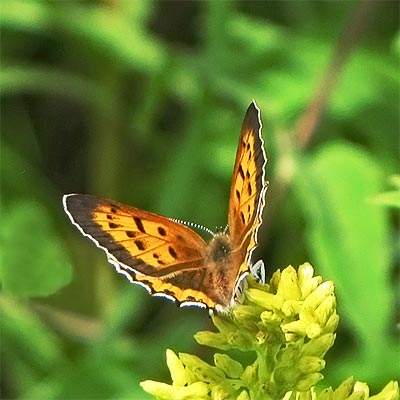Salutations, BugFans,
As butterflies go, the Bronze copper has a pretty standard biography, but we have other issues to tackle here and so will do a little multi-tasking.
Bronze Copper Butterflies
Bronze coppers have gone through a number of scientific names—Hylloycaena hyllus, Lycaena thoe, and Chrysophanus thoe—before settling on Lycaena hyllus. They are in the family Lycaenidae, the Gossamer-winged butterflies, along with the Blues and Hairstreaks. BCs can be found in low, moist areas on both sides of the border from Maine west to the northern Great Plains and south to mid-country. Here in Wisconsin, they are rarer “up north.” One source suggested that the BC, like other coppers, favors areas where drainage is poor.
Adult BCs, especially females, take some nectar. Caterpillars dine only on a few species of the dock (Rumex), especially water dock, and smartweed (Polygonum) in the smartweed family.
BCs are dizzyingly similar to the American copper in their markings but with 1 ½” wingspreads are quite a bit larger than ACs. They are sexually dimorphic—the top surfaces of the male’s wings are dark and plain and the females are orange and black patterned.
[metaslider id=4856]
Males scout for females from low perches. They are not enthusiastic flyers. The eggs are laid on the underside of the largest leaves of the host plant, and there are probably two broods each summer, the first brood more numerous. The second brood overwinters in egg form (eggs laid on large leaves at the base of the plant are sheltered in winter) and emerges in spring to feed. Adults die soon after producing the next generation.
In her on-line research about butterflies, the BugLady frequently comes across the Butterflies of Massachusetts site. As seasoned BugFans can attest, the BugLady is an unapologetic history geek, and along with biographical info about butterflies, the thorough and thoughtful B of Mass site includes all manner of historic documentation. Imagine having 200+ years of data about butterfly species! Of the BC we learn that:
- “The Bronze Copper was described in 1775 by the Dutch naturalist Pieter Cramer, the specimen was collected around 1766, probably in Brooklyn, New York, on Long Island but it has not been seen in NYC since 1982.”
- “There is nothing about the Bronze Copper in [eastern] Massachusetts in Thaddeus W. Harris’ writings, and it is not on his list of insects collected around Boston in the 1820’s. Thoreau, who walked Bronze Copper’s present-day haunts in the Concord area in the 1850s, does not mention it.”
- “To Scudder’s knowledge at the turn of the century, the Bronze Copper had ‘never been taken east of the Connecticut valley’ (1889: 980). This assessment is so at variance with the species’ distribution today that it raises fascinating questions: Did the Bronze Copper migrate eastward only during the 20th century? Could it have been overlooked before 1900 in the Sudbury River valley, or did it arrive there since then?”
- “The Bronze Copper’s main host today throughout its range is reported to be the widespread non-native weed curly dock (Rumex crispus)—another example of a native butterfly adopting a non-native host.”
- “As many authors have remarked, it is curious that the species is thought to be rare or declining in the eastern United States, given the abundance of both curly dock and native and introduced polygonums. There may be aspects of its biology and habitat needs which are not well understood, and climate warming might be having an adverse effect.”
- “The Bronze Copper might have benefited from pre-industrial agriculture in New England, in areas where light grazing or shifting cultivation kept wet meadows open, and encouraged the growth of dock (which cows do not eat) and polygonums. The Bronze Copper should benefit from the preservation of sedgy wet meadow habitat, kept open through light grazing or occasional mowing.”
- “ ‘Man’s penchant for stability may be in conflict with this species’ survival,’ “ writes one author, “presumably referring to ditching, draining, bank stabilization, flood water control, and other efforts to create dry land for house lots and plowable fields.”
According to accounts from several eastern states, BCs are now listed as threatened-endangered-of special concern-rare-absent in many parts of their original range due to draining and filling of their dampland habitats, urbanization, pesticides, and other realities of 21st century life. This, despite the abundance of the sun-loving curly dock along road edges.
And, then there’s this sexual dimorphism thing. What’s that all about, anyway—and by “What” of course, we mean “Why?” Why use the energy? What will it buy you? The term itself refers to genetically governed male-female differences in size, shape, color, behavior, vocalizations, etc. In many bird species, males have bright/exaggerated colors that they use in courtship and territorial defense displays (brighter coloration may be “encouraged” by females that fall for the gaudiest guys), while drab females are camouflaged for their child-rearing duties. Males are larger in some organisms (a male otter is twice the size of a female and therefore eats larger food items and doesn’t compete with her), but female birds of prey are larger, as are many insects and spiders. Egg-producing uses a lot of energy. In dance flies, of previous BOTW fame, the fringed legs of the female are thought to make her look like a wide-hipped fertility goddess. Males are more likely to present food to females that look receptive/fertile, and to further enhance their desirability, females may inflate air sacs located along the sides of their abdomen. It’s a huge and fascinating topic and is ultimately about who gets to pass along their genetic material. Meanwhile—Vive la difference!
Oh yes—butterflies have notoriously poor eyesight, so maybe sexual dimorphism keeps them from wasting their time on members of the same sex. Of course, many butterflies are not dramatically dimorphic.
The BugLady
